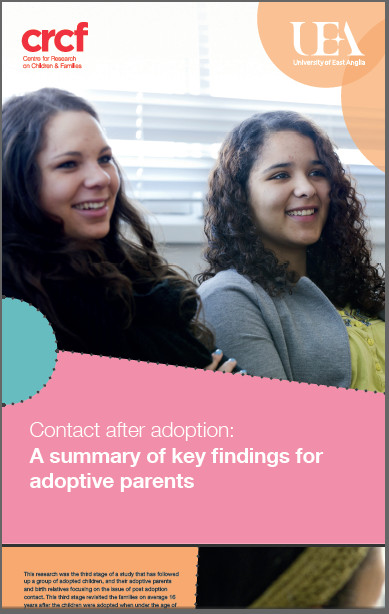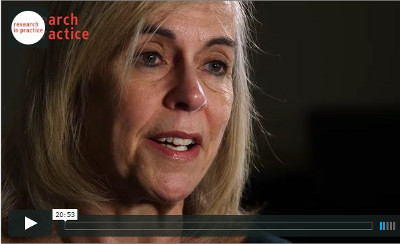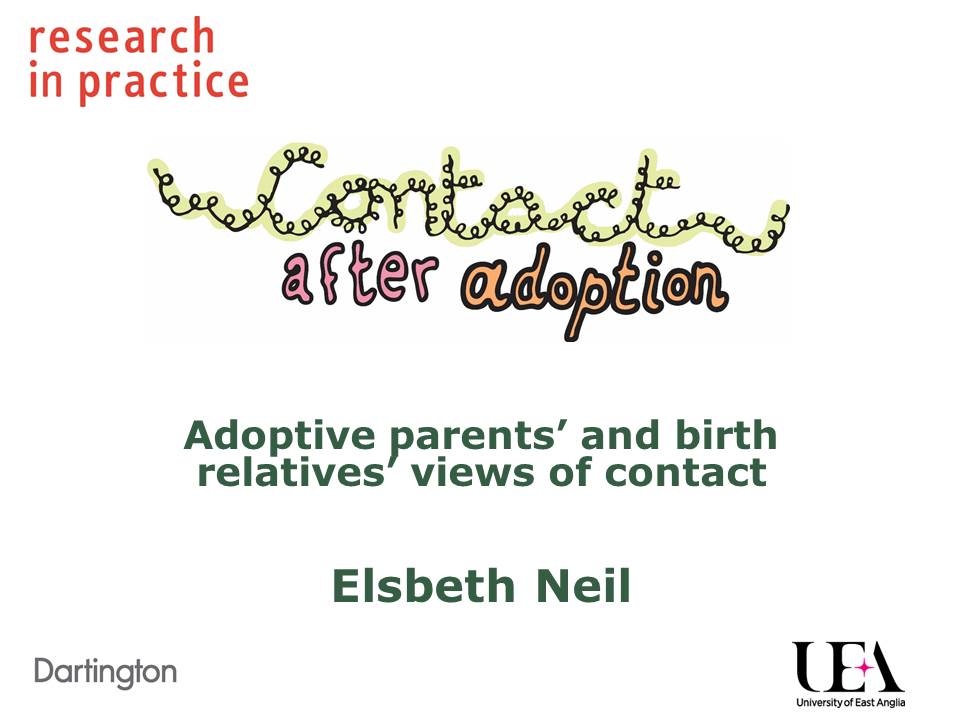Contents
This page contains a series of resources practitioners may find useful to share with adoptive parents during training. It can also be used for individual learning.
Practice briefings
Messages from research for practitioners on supporting adoptive parents’ communicative openness.
Exercises
This section contains a number of exercises that can be used to consolidate learning. They can be used for individual or team based learning. At the end of each sheet you will find some notes highlighting the main learning outcomes for each exercise.
- Exercise: helping adopters to understand the potential benefits of post-adoption contact
- Exercise: helping adopters to understand birth relatives’ feelings about contact
Practice resources
In this section you can find resources practitioners may find helpful for use with families.
Film clip: Liz, an adoptive mother, on opening contact with birth relatives
Film clip: Liz, an adoptive mother, talks about her family’s experience of opening contact with birth relatives
Also viewable online via Adobe Connect
In this film, Liz shares her experience of contact following the adoption of her son. When the placement for adoption was first made the arrangement was for indirect contact (through letterbox). This worked well and built a foundation of trust.
After a few years, the adopted child asked his parents if he could see the grandparents who had kept in touch with him through indirect contact. The adopters discussed this with their social worker and a plan was made for a supported face to face meeting. Face to face contact continued to develop from this point. The adopted child is now in his teens and contact has gradually become fully open with visits to each others’ homes two or three times a year and other birth family members involved occasionally.
The film is divided into sections, covering several aspects of contact including: role of adoptive parents in supporting their child during and after contact and finding information on birth parents trough social media, contact plans and support, and experience of benefits and challenges of contact.
The film may be viewed as a whole or used to illuminate or prompt discussions on specific points, particularly during adopter training. Download the film notes (PDF 274KB) with timings here.
Slide presentation: Birth parents’ and adopters’ views of contact
Download the slides Birth parents’ and adopters’ views of contact (with notes) (953kB) Powerpoint .PPTX file Slide presentation or the PDF version (522kB)
Practice Briefing: working with adoptive parents to understand contact and what it means for their child
This practice briefing summarises points for talking to adopters in cases where either face to face contact or indirect contact has been assessed as being an appropriate plan for their child.
Understanding the context
- Meeting up with your child and their birth family or writing to them are strange situations for which there are no established social rules
- Direct contact visits are highly personal but take place between virtual strangers often in impersonal circumstances with no chance for adults to talk away from the child
Coping with difficult feelings about contact
- Adoptive parents may find contact emotionally demanding because of worry about their child, strong feelings about the harm they suffered and sadness for birth parents. For some adoptive parents, contact with the birth family is a painful reminder that they are not biologically related to their child
- Children’s upset before and after contact can be hard for adoptive parents, but is also a chance to build closeness and talk about feelings
- There is no evidence that direct contact in itself affects the development of adopted children. Experiences before placement, age at placement and the love and care provided by adopters are much more important
- Adoptive parents generally act quickly to stop or pause direct contact if it is harmful to the child
Benefits of contact
- Adoptive parents value contact even if it is difficult when it helps their child by: showing they are loved; reassuring them that they are not forgotten; increasing understanding about their birth family and why they were adopted
- Most adopted children are interested in their birth family, at least at some stage of their lives, even if they have no conscious memories of them
- Adoptive parents value the opportunity to learn more about the child and their family history; having contact with the birth relatives can help to ease anxiety about them contacting the child in future in an unplanned way
- Contact is an opportunity for children and their adoptive families to talk about the birth family and show that children’s feelings and curiosity are accepted. This kind of ‘communicative openness’ helps children do well in adoption
- Contact with birth grandparents often works particularly well
- Contact through social media can work well alongside other positive forms of contact; it is more likely to be difficult if driven by unmet contact needs
What practitioners can do to help
- If relationships between the adults are working well, contact is more likely to work well
- Give clear messages about the potential benefits of post-adoption contact at every stage of recruiting, assessing and training adopters. Encourage communicative openness
- Help adoptive parents to understand the kind of feelings that birth relatives might have and the kind of underlying difficulties that might make contact hard (such as alcohol misuse or mental health problems)
- Encourage adoptive parents to think about their child’s long term identity needs as well as their immediate needs for care and protection
- Prepare for how things may change in adolescence, talk about social media from the start
- Set up an introductory meeting (without the child) between the adults before direct or letterbox contact begins
- Provide opportunities for an on-going exchange of information between birth relatives and adoptive parents so that news can be shared outside of visits (eg birth mother is pregnant, child now wears glasses, adoptive parents have divorced)
- Take a proactive role in getting contact started, easing communication between the adults, reviewing how contact is going and suggesting ways that it might be improved
- Provide practical help with travel arrangements, letter writing, venues, etc
- Provide emotional support for adoptive parents before and after visits or letter exchange, acknowledge strong feelings
- Focus on promoting good relationships between the adults involved, so that the child feels reassured
- Attend contact if needed in an active, supportive rather than supervisory role
- Be clear about roles and expectations: who is called Mummy? Are kisses and cuddles OK? Who takes the child to the loo? Tells them off? Brings sandwiches? Is it OK to ask questions? Bring a present? Share good news? Talk about problems or worries?
- Respect the adoptive parents’ role in making decisions about contact for their child and ensure that they feel in control; step in to help with boundaries if needed; listen to their worries about the child’s response to contact
- Support birth relatives so that adoptive parents can focus on supporting the child
Film clip: young people discussing contact
Young people’s views and feelings: openness with adoptive parents
Listen to four adopted young people talk about their relationship with adoptive parents, what has been important to them and how their adoptive parents have supported contact.
Also viewable online via Adobe Connect
Exercise: helping adopters to understand the potential benefits of post-adoption contact
Download the exercise as a PDF (120KB)
Research message: Adopters may need support to understand the range of benefits post-adoption contact can provide for both themselves, the family and their children.
Contact can help to reassure adopted children that they are loved and not forgotten; it can help them to understand their parents’ difficulties and why they were adopted.
Contact can benefit adopters by helping them to understand their children better and enabling them to answer questions about their birth family; it can also reassure adoptive parents about the possibility of birth parents making unplanned contact. Supporting children with contact can help to build closeness in the adopted family, reassuring the child that adoptive parents accept their thoughts, feelings, curiosity about and connection with their birth family.
This exercise is suitable for: individual learning; use during assessment and training of adoptive parents and in training for contact supervisors and social workers.
Either read the ‘Research Summary Leaflet for Adopters‘ or use the slide presentation on ‘Young people’s views on contact‘ (in page: Voice of the child). Watch the film clip ‘Liz: an adoptive mother, on opening contact with birth relatives’.
Consider and discuss the following questions:
- How did this child benefit from direct contact when it began? As he grew up?
- What might this contact mean for him when he has his own children?
- What were the benefits for his adoptive parents?
- For his birth relative?
- Were there any risks? How were these addressed?
- What do you think made this contact work so well?
Exercise: helping adopters to understand birth relatives’ feelings about contact
Download the exercise as a PDF (129KB)
Research message: if adopters are sensitive to birth relatives’ feelings and able to build positive relationships with them, post-adoption contact is more likely to work well. Successful contact has a series of benefits for adopters and children.
To better understand what birth relatives may be feeling during contact, it is useful to note that:
- Birth relatives may experience a range of emotions around contact including grief, rage, jealousy, relief, joy and reassurance
- They are often fearful of showing their feelings in case this leads to restrictions on future contact and anxious about getting things wrong
- Birth relatives generally value contact highly, even when it is difficult
- Contact with the birth family may include parents but also grandparents or siblings. Their relationship and feelings about the child will be very different.
Practical and emotional support for birth relatives can help.
This exercise is suitable for: individual learning; use during assessment and training of adoptive parents and in training for contact supervisors, social workers and foster and kinship carers.
Either read the summary of key findings from the ‘Supporting Direct Contact’ study or use the slide presentation ‘Birth parents’ and adopters’ views about contact’ on this section. Listen to some of the audio clips of birth parents’ voices (which can be found on the ‘Case studies and media clips‘ section). Read the Mikey Maddox case study (which can be found on the ‘Case studies and media clips‘ section).
Consider and discuss the following questions:
- How might Mikey’s adoptive parents feel about contact with Drew and his mum?
- How could contact help Mikey? How could it help his adoptive parents?
- What might make it difficult?
- How might Drew and his mum feel about their first visit to Mikey, three months after he is placed for adoption?
- What might adopters think of the visit? What will they think of Drew and his mum?
- What questions might Drew and his mum have for adopters?
- What might they want to share with adopters?
- What hopes and fears might they have?
- What might be included in a contact agreement for this child?
- What could adoptive parents do to help make contact go well?
Trainer’s notes
These questions aim to act as a prompt for adopters to try and view contact through the eyes of Drew and his mum, how they will view adopters, Mikey and how they think they will be judged.
Research summary: leaflet for adopters
 This research was the third stage of a study that has followed up a group of adopted children, and their adoptive parents and birth relatives focusing on the issue of post adoption contact. This third stage revisited the families on average 16 years after the children were adopted when under the age of age 4. The study was undertaken in 2012-13 by Elsbeth Neil and her colleagues from the University of East Anglia. It was funded by the Nuffield Foundation.
This research was the third stage of a study that has followed up a group of adopted children, and their adoptive parents and birth relatives focusing on the issue of post adoption contact. This third stage revisited the families on average 16 years after the children were adopted when under the age of age 4. The study was undertaken in 2012-13 by Elsbeth Neil and her colleagues from the University of East Anglia. It was funded by the Nuffield Foundation.
The study aimed to address seven key questions:
- How were the adopted young people getting on in adolescence?
- What types of openness have adopted young people, adoptive parents and birth relatives experienced since the last follow up in middle childhood?
- What are the views of adopted young people, adoptive parents and birth relatives about the contact plans they have experienced?
- How were the adopted young people making sense of their adoptive identity?
- How open were adoptive parents in talking and thinking about adoption with their child?
- How well were birth relatives doing in terms of their mental health and their acceptance of adoption?
- What are the implications for practice that can be drawn from this longitudinal study?







